Near Field Communication technology enables wireless interaction between two NFC-compliant devices up to 10 cm apart. NFC, or Near-Field Communications, is a wireless, short-range technology that is rapidly expanding. NFC approved as an ISO standard in 2003, is a type of RFID technology with a read range of a few centimetres.
What is NFC (Near Field Communication)?
Near Field Communication (NFC) is a short-range wireless communication technology which allows devices to exchange data by bringing them close, typically within a few centimetres. NFC operates in the 13.56 MHz frequency band, allowing for secure and efficient data transfer between smartphones, tablets, and smart tags using electromagnetic fields.
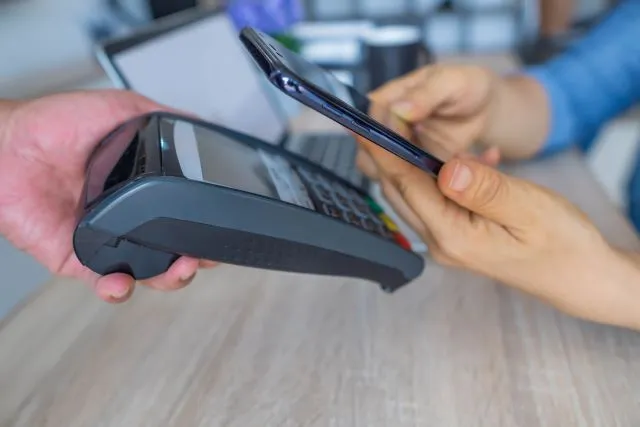
NFC-enabled devices can send and receive data, including small amounts of information such as text, URLs, and contact details.
Product designers use NFC for applications such as contactless payments, ticketing, access control, and data transfer between devices. Businesses can also use it for proximity marketing, delivering targeted advertisements to customers’ devices by bringing them close to an NFC tag.
Overall, NFC is a convenient and secure technology that enables quick and efficient communication and data transfer between devices such as IoT sensors.
Differences between NFC and RFID
NFC (Near Field Communication) and RFID (Radio-Frequency Identification) are both wireless communication technologies used for data transfer and identification, but they have some key differences:
- Range – NFC operates over a short range, typically within a few centimetres, while RFID can be used over a much greater distance, generally several meters.
- Frequency – NFC operates in the 13.56 MHz frequency band, while RFID can work in different frequency bands, including low frequency (LF), high frequency (HF), and ultra-high frequency (UHF).
- Data Transfer – NFC is primarily used for data transfer between two devices, while RFID is used for data transfer and identification. RFID tags can be read without a direct line of sight and store much more information than NFC tags.
- Interactivity – NFC is designed for two-way communication, allowing both devices to transmit and receive data. RFID is a one-way communication technology where the reader reads the tag but does not respond.
- Power Source – NFC devices can be either active or passive, while RFID tags are typically passive and derive their power from the electromagnetic field generated by the reader.
In summary, NFC and RFID are similar in that they are both wireless communication technologies, but they have different capabilities and are used for various purposes. For example, NFC is best suited for short-range data transfer between devices, while RFID is best suited for identification and data transfer over a more extended range.
Modes of operations
NFC can operate in either passive or active mode.
Active Mode
The NFC device generates its electromagnetic field to initiate and maintain communication with another NFC device. An active NFC device provides power to a passive NFC device, enabling the passive device to operate and respond. Active NFC devices consume more power than passive devices but offer faster communication speeds and longer communication distances.
Passive mode
In passive mode, the NFC device functions as a passive receiver and does not provide its power source. Instead, it derives power from the electromagnetic field generated by an active NFC device.
Modes of communication in Near Field Communication
NFC technology has three modes of operation depending on the application.
Reader mode
An NFC-enabled device can read and write data to an NFC tag. For example, in reader mode, a smartphone behaves as a contactless reader that can communicate with a battery-less NFC tag (RFID label) first to use it to access information. This would take the form of Touch and Go, where a simple tap gives you access to something like a review, a menu, or a direct referral to a website or video. It can also operate like a debit card for micro-payments on a prepaid basis, such as the Oyster card.
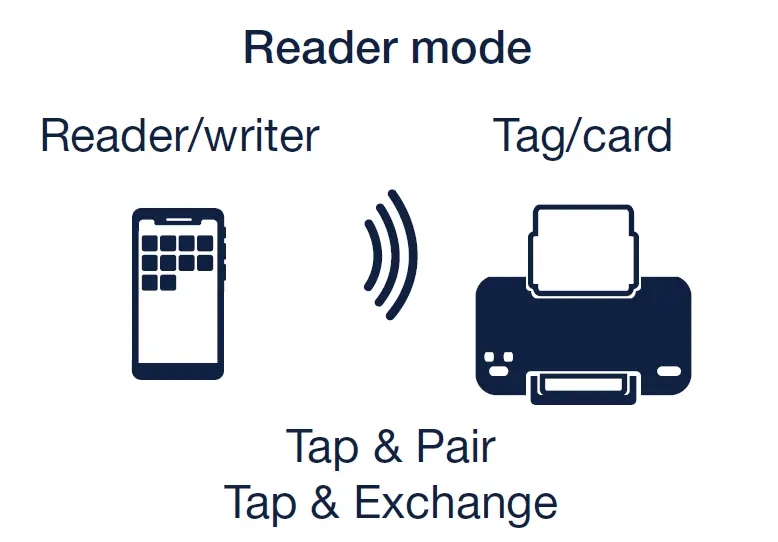
Card Emulation mode
Card emulation is the use of an Active NFC device for contactless payment. This mode allows an NFC-enabled device to act like a smart card and be read by an NFC reader.
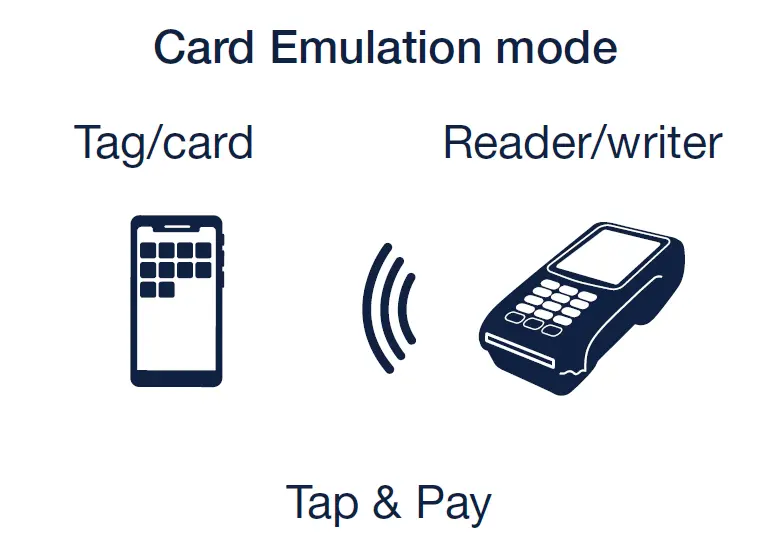
Peer to Peer mode
In peer-to-peer mode, active NFC devices exchange data by switching between passive and active states. Enables two NFC-enabled devices to communicate and exchange data.
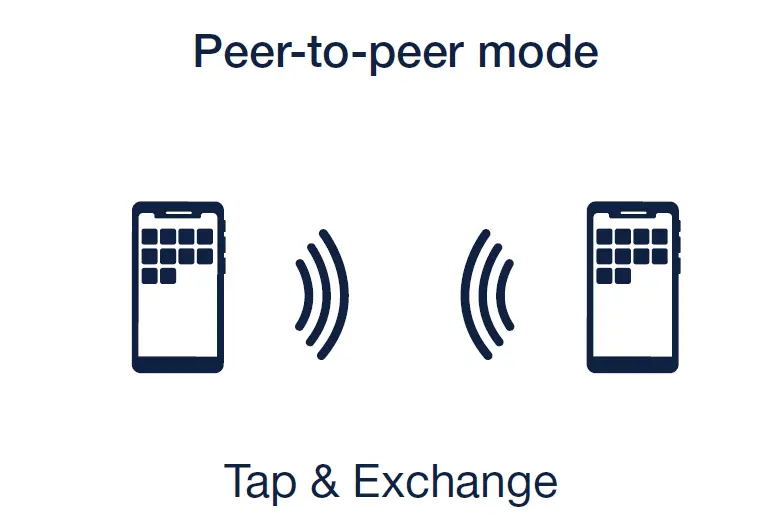
What is an NFC tag?
An NFC (Near Field Communication) tag is a small, passive device that stores and transfers data to an NFC-enabled device, such as a smartphone, when brought close to the tag. NFC tags contain a small microchip and antenna and can be embedded into various forms such as stickers, key fobs, or cards. The data stored on an NFC tag can be read by an NFC-enabled device and used for multiple purposes, such as opening a URL, launching an app, or accessing stored information such as a business card or personal details. In addition, NFC tags are often used for contactless payment systems, data transfer, and location-based services.
Tag types
Several NFC (Near Field Communication) tag types can be classified based on memory size, read-write capability, and other features. Some of the common NFC tag types include:
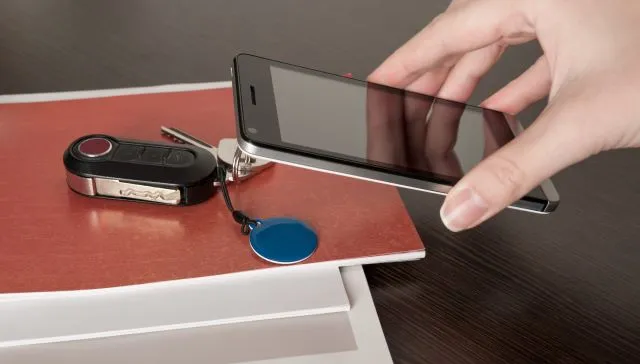
- Type 1 Tag (NFC Forum Type 1 Tag) – This simple, low-cost tag can store up to 48 bytes of data and is often used for small amounts of information, such as URLs or launching an app.
- Type 2 Tag (NFC Forum Type 2 Tag) – This type of tag is more versatile than Type 1 and can store up to 2 KB of data. It also can be locked and protected from unauthorized writing.
- Type 3 Tag (FeliCa Tag) – This type of tag is primarily used in Japan and can store up to 64 KB of data. It is used for mobile payments and public transportation systems.
- Type 4 Tag (NFC Forum Type 4 Tag) – This high-end tag can store up to 32 KB of data and work with various operating systems and applications.
- NTAG Series – This proprietary tag developed by NXP Semiconductors is widely used in gaming, event ticketing, and product identification applications.
These are some commonly used NFC tag types and other specialized tags for specific applications. The type of tag used depends on the application’s requirements and the data that must be stored.
What is an NFC reader?
An NFC reader can be any powered device with its own NFC coil (such as a smartphone or tablet). The reader device’s battery powers an electromagnetic field that powers any tag brought close to it. A payment terminal is another typical example of a reader, as it uses NFC to authenticate a debit or credit card.